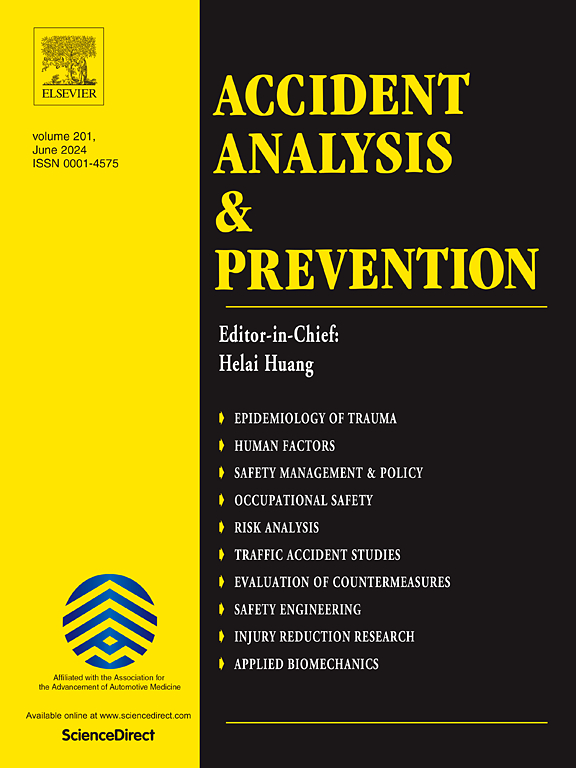Investigating the influence of socioeconomic factors on the relationships between road characteristics and traffic crash frequency and severity-- A hybrid structural equation modelling − artificial neural networks approach
IF 5.7
1区 工程技术
Q1 ERGONOMICS
引用次数: 0
Abstract
Traffic crashes result from complex interactions between driver, roadway, and environmental factors, which traditional methods often fail to capture. This paper investigates the influence of road, weather, and socioeconomic factors on traffic crashes, using a two-stage hybrid Structural Equation Modelling (SEM)-Artificial Neural Networks (ANN) approach to capture the complex relationships between these factors and crash intensity, a variable that jointly captures the frequency and severity of crashes. A database from Ohio collector road segments served as the case study in this novel hybrid approach, which utilized SEM to analyze the complex and moderating relationships between different factors and crash intensity. SEM revealed significant relationships between crash intensity and factors such as “Horizontal Curve,” “Road” (AADT and surface width index), “Segment Length,” “Speed Limit,” “Vertical Curve,” and “Vehicle Possession.” Based on the SEM results, “Vehicle Possession” significantly moderated the relationship between “Horizontal Curve” and crash intensity. In the next step, ANN further identified key predictors, including “Segment Length,” “Road,” the interactions of “Vehicle Possession-Speed Limit,” “Vehicle Possession-Vertical Curve,” and “Age-Road.” The findings highlight the advantage of the complementary application of linear and nonlinear methods in providing invaluable theoretical and methodological insights for crash data analysis.
研究社会经济因素对道路特征与交通碰撞频率和严重程度之间关系的影响——一种混合结构方程模型-人工神经网络方法
交通事故是驾驶员、道路和环境因素之间复杂的相互作用的结果,而传统的方法往往无法捕捉这些因素。本文研究了道路、天气和社会经济因素对交通事故的影响,使用两阶段混合结构方程建模(SEM)-人工神经网络(ANN)方法来捕获这些因素与碰撞强度之间的复杂关系,碰撞强度是一个共同捕获碰撞频率和严重程度的变量。该方法以俄亥俄州收集路段的数据库为例,利用扫描电镜分析不同因素与碰撞强度之间的复杂和调节关系。扫描电镜显示,碰撞强度与“水平曲线”、“道路”(AADT和路面宽度指数)、“路段长度”、“限速”、“垂直曲线”和“车辆拥有量”等因素之间存在显著关系。SEM结果显示,“车辆拥有量”显著调节了“水平曲线”与碰撞强度的关系。下一步,人工神经网络进一步确定了关键预测因子,包括“路段长度”、“道路”、“车辆拥有量-速度限制”、“车辆拥有量-垂直曲线”和“年龄-道路”的相互作用。研究结果强调了线性和非线性方法互补应用的优势,为碰撞数据分析提供了宝贵的理论和方法见解。
本文章由计算机程序翻译,如有差异,请以英文原文为准。
求助全文
约1分钟内获得全文
求助全文
来源期刊

Accident; analysis and prevention
Multiple-
CiteScore
11.90
自引率
16.90%
发文量
264
审稿时长
48 days
期刊介绍:
Accident Analysis & Prevention provides wide coverage of the general areas relating to accidental injury and damage, including the pre-injury and immediate post-injury phases. Published papers deal with medical, legal, economic, educational, behavioral, theoretical or empirical aspects of transportation accidents, as well as with accidents at other sites. Selected topics within the scope of the Journal may include: studies of human, environmental and vehicular factors influencing the occurrence, type and severity of accidents and injury; the design, implementation and evaluation of countermeasures; biomechanics of impact and human tolerance limits to injury; modelling and statistical analysis of accident data; policy, planning and decision-making in safety.
 求助内容:
求助内容: 应助结果提醒方式:
应助结果提醒方式:


